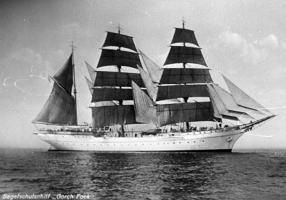
Gorch Fock
Three years ago, the BBC published an article with the clickbait title of “Why is the US still using a Nazi tall ship?” The article was about the USCG Cutter Eagle and was OK as far as it went. The title itself was absurd and was largely ignored in the body of the text.
The Eagle was built as the Horst Wessel, one for five sail training ships built at Blohm & Voss, Hamburg, largely for the German Kriegsmarine prior to World War II. They were all near sisters of the Gorch Fock, a three-masted barque, delivered in 1933. And yes, they served as school ships under the Nazis, before being divided up as war reparations at the end of World War II. Despite the ignoble first owners, these five ships have had an oversized impact on sail training in the world’s navies. Remarkably, the four of the original ships which saw service all survive to this day and three are still actively sailing. The Gorch Fock design has also influenced training ship designs around the globe.
Gorch Fock ex Tovarishch ex Gorch Fock
The capsize of German school ship Niobe in July of 1932 in a sudden squall, killing 69, prompted the German Navy to order a series of new training vessels. The Gorch Fock, named in honor of the German sailor poet, Johann Wilhelm Kinau, who wrote under the pen name, Gorch Fock, was built as a three-masted barque with a sparred length of 269′, setting 18,870 sq. ft. of sail area. During World War II, the ship was used primarily as a stationary office ship in Stralsund. Reactivated in 1944, she was scuttled to avoid capture by the Soviets the following year.
Salvaged and restored by the Russians, she was put into service as the training vesselTovarishch and sailed until 1991, winning many tall ship races. With the collapse of the Soviet Union, she sailed under the Ukrainian flag until 1993, when she was laid up. She is now a museum ship in Stralsund, Germany, under her old name, Gorch Fock.
There is, however, another near sister ship also named Gorch Fock. In 1958, the German Navy built a slightly improved version of the original design at Blohm & Voss. The newer Gorch Fock, sometimes informally referred to as the Gorch Fock II, is still sailing as a German naval training vessel.
Eagle, ex Horst Wessel
The Horst Wessel was built at Blohm & Voss in 1936. She is slightly larger than the Gorch Fock with steel rather than wooden spars. After the end of the war, she was taken as war reparations by the US. Rechristened USCG Cutter Eagle, she has served as a training ship for USCG Academy cadets on summer training cruises since 1946.
NRP Sagres ex Albert Leo Schlageter
Albert Leo Schlageter was built at Blohm & Voss in 1937. After the war, she was sold to Brazil and sailed as a school ship for the Brazilian Navy under the name Guanabara. In 1961, she was sold to Portugal and was renamed NRP Sagres. She currently sails as a school ship in the Portuguese Navy.
Mircea
Mircea was built in 1938 as a training vessel for the Romanian Navy. She was the only ship of the Gorch Fock class not built for the German Navy. She is still sailing under the Romanian flag as a training ship.
Herbert Norkus
Herbert Norkus, the last of the original Gorch Fock class, was started in 1939 but never completed. Damaged by bombing raids during the war, the unfinished hull was ultimately towed out and sunk.
Ships Inspired by the Gorch Fock Class
A number of ships built for South American navies are thought to have been inspired by the Gorch Fock class of training ships, including Columbia’s Gloria, Equador’s Guayas, Venezuela’s Simón Bolívar, and Mexico’s Cuauhtémoc.

It is interesting to note that asTovarishch, she played a small part in the beginning of detente between the US and the USSR, when she paid a port visit to city of Baltimore in September of 1972. I was a young firemen 1st Class in the Maryland Naval Militia, a training organization funded by the State of Md for young men and women who had interest in careers at sea. The visit of the Tovarishch was, at the time, groundbreaking and controversial. It provided a unique exposure for us boys, as we soon discovered the Russian cadets had plenty of trinkets to trade and a black market of sorts was soon established, consisting of Marlboro Red’s, Kool’s, and M & M’s …